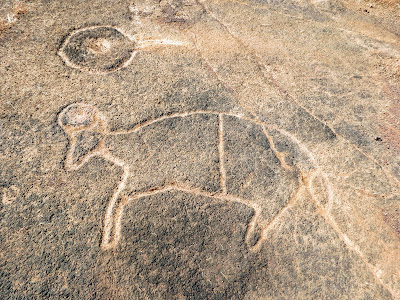"The western coastline of India encompassing coastal districts of Maharashtra, Goa, and Kamataka collectively known as Konkan, extends 720 kilometres north-south. Lying between the Arabian Sea to the west and the mountain ranges of Western Ghats to the east in the state of Maharashtra, Konkan includes the regions of Thane, Greater Mumbai, Raigarh, and Ratnagiri. Geographically this region is traversed by seasonal rivers that drain the heavy monsoonal rainfall from the crest of the Sahyadri Hills." (Garge et al. 2018:39)
Rock art in this region had been intermittently reported from about 1990, but the first large scale systematic surveys were conducted by hobbyists (locals) from 1980 onward. Sudhir Risbud, later joined by Dhananjay Marathe and Surendra Thakudesai, explored the region and in 2010 formed a group called Unexplored Konkan to discover and record this rock art. Efforts snowballed as other locals became interested, and in 2018 the State Archaeology Department got involved and set up a fund for the study. "As of January 2019 there have been 52 confirmed and explored sites, and over 1,000 petroglyphs discovered. A further 16 sites have been confirmed but (have) yet to be fully explored and recorded." (Standage 2019)
Animal figures - Herbivores such as elephants, rhinos, deer family animals, pig, rabbit, buffalo, wild boar, monkey, etc. and carnivores like tiger, etc.
Birds - Peacock and large unidentified bird species.
Aquatic animals - Shark, stingray, and many more unidentified species of fish.
Amphibious animals - such as tortoise, alligators, etc.
Anthropomorphs - Human figures including mother goddess like figures.
Abstract - Various geometrical patterns." (Garge et al. 2018:42)
You will notice that the larger than life elephant in the fourth illustration, as well as the smaller one by the end of his trunk, appear to have their ears raised above their heads. Raised, flapping ears in an elephant is supposedly a sign of anger and I wonder if this is an attempt to portray the emotion of the subject of the petroglyph, the elephant.
There are also complicated geometric patterns that reminded me immediately of Rangoli designs like those created for Diwali and other Hindu festivals.
"Rangoli is an art form, originating in the Indian subcontinent, in which patterns are created on the floor or the ground using materials such as colored rice, dry flour, colored sand or flower petals. Designs are passed from one generation to the next, keeping both the art form and the tradition alive." (Wikipedia) While the main purpose of Rangoli designs is decoration, they are also thought to bring good luck, and they are traditionally done by the women of the family. (Wikipedia)
It would appear that the petroglyphs reported so far are only the beginning, and that we can hope to see considerably more wonderful rock art from India in the future.
NOTE: I want to thank Rhutvij R. Apte and his co-authors for their work, and for providing their paper and photos, and cooperating with RockArtBlog on this report. Check it out at the address below. Also, the reference above to Rangoli designs is wholly mine, this is not from their report.
REFERENCE:
Faris, Peter
2019 Ancient Rock Art of India - The World's Earliest?, https://rockartblog.blogspot.com
https://en.wikipedia.org/wiki/Rangoli
Standage, Kevin
2019 The Konkan Petroglyphs - Introduction, March 14, 2019, https://kevinstandagephotography.wordpress.com
Tejas M. Garge, B.V.Kulkarni, Rhutvij R. Apte, and Sudhir Risbud
2018 Petroglyphs in Konkan: Historiography, Recent Discoveries, and Future Endeavours, Purakala 2018, Volume 27-28, pages 39-47.












That Histroy is great
ReplyDelete